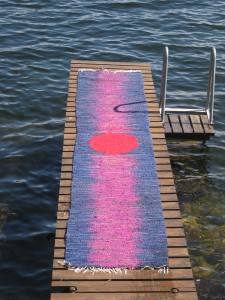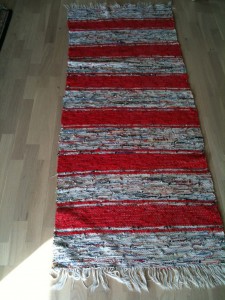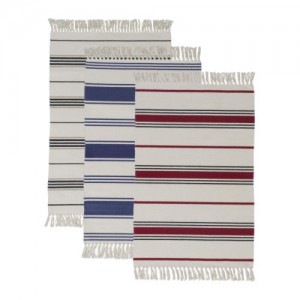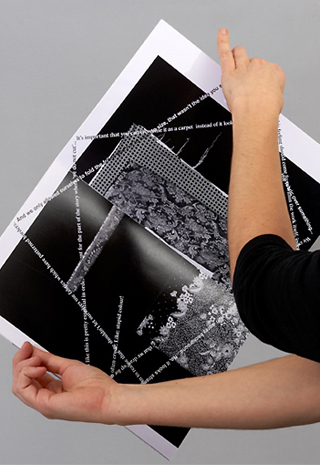I want to tell you about my grandmother and needlework.
My grandmother had a big house and in one of the rooms she had a weave. On the weave she made tablecloths and carpets out of old sheets and fabrics. She ripped the fabric in to long thin strings and weaved them in to carpets. Some of the carpets she made where for her own house, some for the summerhouse and others to give away to family and friends.
My grandmother had an education as a nurse but after she married my grandfather she became a housewife. No busy work life for her but instead she had time to do different kinds of needlework an of course be a wife and mother. After her children moved out of the house she also developed new interest such as hunting to spend more time with my grandfather who was a keen hunter. But enough about her life story so far because this text is about the needlework she made and her as an example for a generation of woman and design.
The carpets she made are called kludetæpper in Danish, which directly translated means rag carpets in English. A better word for it in English would properly be patchwork carpets. The technique is that you ripe a bunch of old fabrics such as sheets or bed linen into long thin shreds about one centimetre wide. You then weave the shreds together again into rectangular carpets. The results is colour full thick carpets. When weaving you can also make patterns or motifs in the carpets by selecting the specific colours and then applying them in a pattern. The more traditional look of the carpets is a wide blend of colours without a specific pattern or motif.
 A patchwork carpet my grandmother made
A patchwork carpet my grandmother made
The patchwork carpet was first used or thought of as way to save money and recycle old fabrics into new things for the home. Instead of buying new when you didn’t really have the money you could save cost by ripping you old sheets and tablecloths and make it into a carpet. In the cold Scandinavian winters it was properly also a good way to keep a way the long and dark hours of the winter by keeping busy with weaving.
The carpets themselves as design object tells, us about the making of the carpet and the history in the fabric. Because it is woven out pieces of fabric and not tread you can see and feel, by touching the carpets, the way they where made and the fabric that was used tells us about the reuse of material and lets us guess where it comes from and what it was used as before.
In 1899 needlework became a mandatory subject in Danish school and to this day every child has it in school. The difference from then to today is that the classes are now for both sexes. It used to be divided in needlework classes for the girls and woodwork classes for the boys. They started teaching needlework to girls from poor working classes family to give the girls a possibility for an extra incoming.
After the Second World War there was a big welfare boom in Denmark and the average Danish man became more wealthy with own car, a good job, a house and money enough to let their women stay at home fulltime “hausfraus”.
Needlework became a status symbol as well a project for them selves that at the same time had practical function such as a carpet to put on the floor to keep a way the cold or dust. It was a status symbol in the way that it signalled extra energy and time, it supported the public idea of the ideal housewife that takes care of husband, children, the house and still had time to do needlework in the evening when the husband was smoking his pipe and reading the paper. In a male dominated society and also art scene needlework was also one of the more accepted ways for women to be creative. Of course there where female artist trying to support them self’s as artist but they where exceptions not the rule and they didn’t fit in to the norm of women of that time. Society didn’t allow the possibility to necessarily be artist, woman, wife, and mother at the same time.
To return to my grandmother she was born by a painter (my great grandfather) and a trained photographer (my great grandmother). Her parents didn’t marry until she was 7 years old because my great grandfather was already married and his wife wouldn’t give him a divorce until 8 years after he started the affair. In the summer holidays of my grandmother childhood she was sent to family in the country while her parents went of into Europe looking for inspiration. She spent some of her time with her aunt who was a professional hat maker. During the 2 World War she was a young woman. My grandmother was creative as a child maybe because creativity surrounded her. She never became an artist and she would properly never call the needlework she did for art, design or anything in between. To make the carpets was her way of being creative but in a functional and economical way (“nothing should go to waste”).
 Another patchwork carpet she made
Another patchwork carpet she made
What women like my grandmother did when making needlework very much relates to the work of a designer. My grandmother thought of the function, colours, pattern and the over all aesthetics much like a designer would do she just never got paid for it or saw it as a job but more as a hobby with a practical function and her possibility to be creative.
The tradition of making kludetæpper (patchwork carpets) has almost disappeared today. Our society has changed both in economical standard, with a consumer society based on buy and throw away and woman social position has also changed. Woman are working and the norm is not to be a stay at home wife anymore. Woman now a days choose to spend their free time differently for example with their children and husbands on family outings instead. Of course there are still people practising old styles of needlework but it is not as common anymore. The easiest way to get a kludetæppe now a days is in Ikea, it is cheap and you only have to drive to the store and by it.




